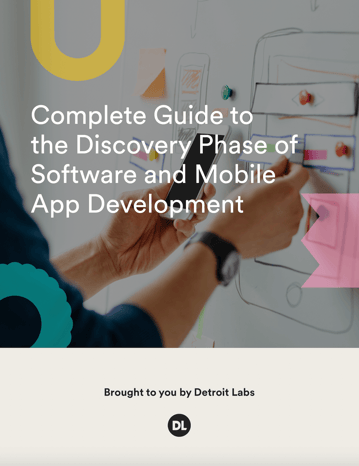Scroll down to read or save a copy.

Imagine if the makers of Spotify launched blindly without considering users. Imagine if Slack white-labeled AOL Instant Messenger as a “workplace communication tool.”
Exceptional solutions are born from even better planning. That’s where the discovery phase of software and mobile app development comes in. Journey with us as we explore discovery and how Detroit Labs uses the process to give you more.

Idea >> Build >> Profit.
If only it were that simple! Unless you live and breathe development, it’s easy to overlook the vast amount of legwork required to build effective software solutions. But every project must begin with a discovery phase to set it up for success.
Unlike a design sprint—which validates your idea—discovery is a weeks-long research and planning process comprising everything from pain points to objectives. During the discovery phase, your development partner works hand in hand with you on various deliverables, including:
By taking the time for discovery, you and your development partner can cover all your bases, reducing risks and minimizing costs. You should walk away with core pieces that will guide your solution, including specifications, architecture, wireframes, cost estimates, risk assessments, designs, and more.
You might not be breaking any laws by skipping discovery, but you’ll do your project a disservice by forging ahead without it. Software development can be unpredictable, so problems with the project or end product are more likely without discovery.
If you’re on the fence about the discovery phase of software development, do a little thinking. Ask a few questions before you move ahead:
In doing your due diligence, you gain the clarity and confidence to pursue a specific solution.

Developing a new software solution is a huge undertaking, so it’s no wonder most leaders are rattled by it. In fact, 75 percent of them feel “doomed right from the start.” But discovery clears the cobwebs and accounts for the biggest hurdles, providing the peace of mind needed to be successful.
IT projects are notorious for overreaching, typically running 45 percent over budget and 7 percent over time. During discovery, you crack the window and expose what it will take to build the product you want— including the features, technologies, time, and money it’ll take to get the job done. With this information, your team can more accurately forecast budgeting needs and make it easier for your company to approve the project’s budget.
“What solution is worth testing and investing in?” Discovery enables you to determine what makes sense for the project—both overall and for the teams involved. That might mean nixing some ideas right out of the gate because they don’t align with your needs or your users, but it’ll get you closer to the best solution.
Risk and reward might go together like PB&J, but like the sandwich, you need to balance the two ingredients. Mitigate professional and monetary risks during this key planning phase by doing the legwork to understand how people will use your software. It could mean the difference between success and failure.

It seems like everyone is involved in discovery because it’s such a collaborative process, and that’s not far from the truth. You need a lot of voices in the room to flesh out your software concept, so it can be tricky to hear the right ones over the noise. Be sure to pass the mic around for insights from:
You need the right team to carry out your software build, make a comprehensive discovery possible, and give your project a fighting chance. Ask yourself—and them—a few questions to guide the selection process:
In a sea of development companies, you need to choose the right fit. Start by selecting a company that understands industry best practices and is devoted to quality.

At Detroit Labs, we’re huge proponents of executing software development the right way. To us, that means doing the hard work that comes with discovery. We don’t skimp on getting to know you, your goals, or the audience you wish to reach with a new software solution, so our process is extensive.
Our discovery process begins with sales, and that is sometimes confusing. A common question we get is, “Why do I need to meet with sales if discovery is planning what this will look like and cost us?”
That’s a fair concern, and we operate this way for your benefit. Our designers and developers put their noses to the grindstone to create your product, but you still need someone who understands your perspective. Sales is that go-between, acting as a liaison and translating your biggest pain points.
Sales introduces the discovery at your pace and on your terms. Our team explains what discovery is and how it will be personalized for your project, including:
Remember: Development is an investment! Sales will continue along your journey, explaining how Detroit Labs works after discovery and through the lifecycle of your project so that you never wonder why, how, or when something will happen. The team will even help get you acquainted with your development team.
When you meet with the team for the first time, have your ducks in a row. The more information you can provide about your needs upfront, the better. Sales will schedule brief get-to-know-you calls on the books to ensure that both sides click and to get a pulse for your needs. If it’s a match, you’ll proceed with a more detailed discussion.
Proposal time! If it is a match made in heaven, we put it on paper. Your proposal will have a few key ingredients, including:
If everything looks good once we formally pitch the proposal to you, Detroit Labs will be nearly ready to rock and roll. Sales will conclude by creating your statement of work. Once we have your John Hancock, the magic begins! From here on out, your delivery lead is your go-to resource.
Discovery is complicated, but it’s well worth the effort, giving a 360° view of what you want to do, where the market is, and how to move forward. Detroit Labs provides several discovery phase deliverables that make all the difference to your project’s success, especially if you’re on the fence about the process to begin with.
The best way to get ahead is to scope out the competition. Your favorite sports teams do it, and so do we. In the case of software development, our process goes beyond the plays the other teams are making. Instead, we look at three key pieces:
What niches can you fill? You’ll lure customers from the competition by filling a gap that so far has been left open by other solutions.
What’s at the top of your list for your new product? If you aim for sheer perfection out of the gate, your project will never launch. So take the time to discuss what matters the most to release a minimum viable product (MVP).
Example: Your new hospitality app could be equipped with mobile booking at launch, but wait to deploy an update that activates the capability for guests to purchase add-ons during their stay.
Your discovery team can provide perspective and a suggested cadence of activity, narrowing down countless variables. What items need to be incorporated now, and which ones can wait for subsequent product updates?
OK, we see where you would like to go now. By working together to understand what you want to accomplish, Detroit Labs can put you on the path toward building your product, defining the right technologies to make it work, and noting any obstacles standing in the way.
We’ll start creating a blueprint for the product with a wireframe that includes:
But that doesn’t mean we’re done. We keep looking at the landscape of your product, continuing through the eyes of prospective users.
If you want to know how users will experience your software, TALK TO THEM! You have at least a rough idea of who you’re targeting, so the discovery team will help you talk to them to understand their needs, pains, desired features, and more. This ensures you’re headed in the right direction and saves significant time, money, and energy if you’re not.
In addition to talking to real people, this valuable discovery research also helps you and your development team create personas. These fictional representations of different user groups inform your requirements and design—and even provide a fluid reference point so you can reassess and adjust your priorities.
So how could your users experience your software from beginning to end? The only way to know that before the product is built is with a storyboard of sorts—or a journey map. Detroit Labs uses journey maps as a visual representation of a customer’s journey with your product, unraveling the critical moments to shape the personality, interactions, and experience of your product.
The important thing to remember is that journey mapping requires empathy. We as developers and you as the client need to put ourselves aside and look on like observers, ensuring the product will be relevant in every stage of the buyer’s journey.
If there’s one thing we can’t stress enough, it’s that between all the moving parts of discovery, the process is fluid. New features are identified, priorities change, and discovery often needs to react to this. As a result, activities and deliverables could change based on what’s uncovered throughout the process.
Queue the Guns N’ Roses: “Where do we go now?”
Whether yours is a 4-week or 12-week discovery phase, we take the same approach moving into development, and that means having a serious sit-down to discuss what’s next.
Discovery is collaborative, but putting everything together is a different animal. When we sit down to review the process with you, Detroit Labs goes over everything from your discovery phase, including:
Our team gets everyone on the same page, unraveling the research we’ve done and digging into the plans we’ve developed to build your software. We’ll review it all, including:
Our goal in discovery is to provide a blueprint of the next steps to move forward instead of leaving you guessing. You’ll walk away with concrete facts and figures on what it’ll look like to take your idea from dream to reality, from the team you’ll work with to the investment and the projected timeline.
“I need a solution ... yesterday!” It’s tempting to forego the discovery phase of software and mobile app development, but your product could miss the mark if you cut corners. Discovery allows you to peel back the layers of what you want to accomplish, align with audience needs, prioritize what matters most, and set your expectations for the project.
Detroit Labs follows tried-and-true methods to inform the process. From scoping out the competition to getting inside the heads of prospective users, our team obtains the details that’ll guide you toward a successful software product.
Speak with our team today about your software idea and kickstart the delivery process.
